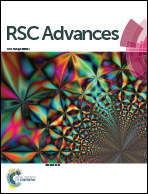Online determination of sulfide using an optical immersion probe combined with headspace liquid-phase microextraction
Abstract
A new design for headspace liquid phase microextraction in combination with an optical immersion probe (HS-LPME-OIP) was proposed and successfully tested for the determination of sulfide in wine and water samples. The developed method is based on the release of hydrogen sulfide from the aqueous phase after the addition of orthophosphoric acid and its extraction with an aqueous solution of 5,5′-dithiobis-(2-nitrobenzoic) acid (DTNB). The analytical signal was recorded using an optical probe immersed in a vial containing 200 μL of 0.1 mM DTNB solution. Using the optical immersion probe in combination with HS-LPME allowed to register the analytical signal online and significantly improve the reproducibility of sulfide determination compared to known microextraction approaches. In the proposed approach, the problems with drop stability, limitations in mixing rate or extraction time, too small volume of the acceptor phase and stability of the holding the acceptor phase in the hole of the optical probe were also satisfactorily solved. The calibration graph was linear in the range of 16–256 μg L−1 with a correlation coefficient of 0.9992. The limit of detection was 6 μg L−1.



 Please wait while we load your content...
Please wait while we load your content...